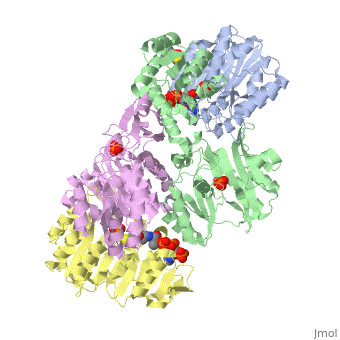Function
Succinyl-CoA synthetase or succinate-CoA ligase catalyzes the reversible reaction of succinyl-CoA + NDP + Pi <-> succinate + CoA + NTP (where N is either adenosine or guanosine. It can be found in Escherichia coli and is the fifth step in the citric acid cycle. Due to its involvement in the citric acid cycle it is very important in all living cells that use oxygen as a part of cellular respiration. This entire process (Citric acid cycle) is necessary in producing one GTP or ATP, three NADHs, and two carbon dioxides. See also:
Structure
Succinyl-CoA synthetase or Succinyl-CoA ligase is a tetramer with an active site on each subunit. This can be seen in the Jmol representation (the PDB code is 1CQJ). The two subunits are denoted alpha and beta. A phosphorylated histidine intermediate is responsible for the dephosphorylation of ATP and it is suspected that there is another active site on the beta subunit that is responsible for the continued catalysis of the reaction. There is a suspected nucleotide binding site on the N-terminal of the beta subunit which would imply that there are two active sites roughly 35 A apart from each other and that the HIS 246 alpha loop moves between them during catalysis.[1]
On the alpha subunit it has been shown that interacts in some way with the active HIS 246 alpha residue in the phosphorylated and dephosphorylated enzyme and it is supposed that GLU 197 beta serves a similar purpose on the beta subunit.[2]
Mechanism
The histidine residue involved in the (de)phosphorylation of (ATP)ADP acts through the following mechanism.
A cooperative binding catalysis mechanism has been proposed and it has been shown that binding of ATP at one catalytic site promotes catalytic activity at another catalysis site.[3] It has been shown that the enzyme will bind with ATP in the presence of Mg+2 to form a complex containing 2 ATP residues as well as 2 phosphoric acid residues, after incubation this the complex converts to another one containing 4 phosphoric residues per protein. Only the second complex reacts with succinate and CoA to form the succinyl-CoA complex which then releases as many phosphoric residues as bound succinate.[4] A transfer of the phosphoric residue from the first active site is seen to be coordinate with a transfer of a phosphoric residue to the second active site suggesting again a cooperative binding catalysis. This cooperative catalysis means that the presence of ATP or ADP can be both activating and inhibiting depending on the stage of catalysis they interact with the enzyme.
After the Succinyl-CoA has been phosphorylated and subsequently dephosphorylated it is release as succinate which continues along the Krebs cycle.
Bound Form of Succinyl-CoA synthetase
The form of succinyl-CoA synthetase shown here (PDB code 1CQI) is the bound form with two (the ADP is highlighted and the Mg is in green).[5] As seen here, the residues on both the alpha and beta subunits are present and interacting with the lone Pi group while the ADP group is bound elsewhere on the subunit.
Kinetics
It has been shown in E. coli that Succinyl Coa sythetase does not have a steady state kinetic pattern. What has been seen is a kinetic pattern that is consistent when the sequential addition of all substrates is done, to form a quaternary structure before releasing any products. This would then give evidence of a limitation on the initial rate kinetics. This is because the order of substrate attachment and product release is limited.[6] And as seen previously the reaction is dependent on the presence of either GDP and GTP or ATP and ADP and the amount of concentrations that they are present at.
Regulation
Succinyl-CoA synthetase is not a major regulator in the Krebs cycle, making it dependent on the steps prior. However, there has been evidence that a high-affinity GDP-binding site does allosterically regulate the activity of the enzyme. It has also been seen that the binding of GDP to these allosteric sites actually leads to an increase in the rate of phosphorylation of Succinyl-Coa synthetase. This could be due to the fact that GDP is probably altering the affinity of the enzyme for GTP.[7]
3D structures of succinyl-CoA synthetase
Succinyl-CoA synthetase 3D structures

